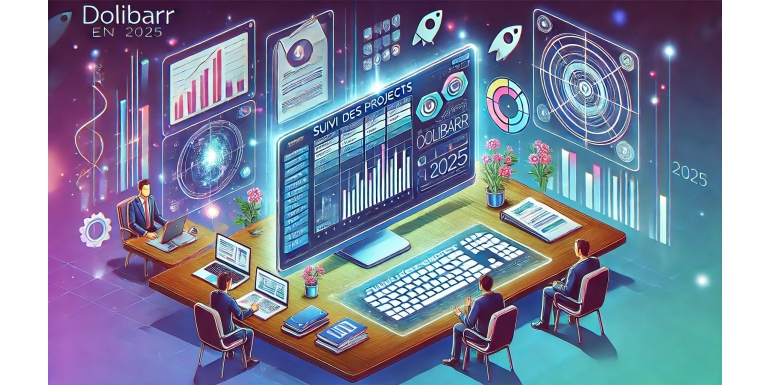
In 2025, Dolibarr ERP/CRM remains an essential solution for project management within small and medium-sized enterprises (SMEs). Thanks to its flexible project management module and numerous enhanced features, Dolibarr facilitates the organization, tracking, and management of projects. However, a good understanding of its functionalities is necessary to fully leverage this tool.
In this article, we will explore the best practices and tips to optimize project tracking with Dolibarr in 2025. We will cover essential features, useful integrations, and advanced techniques to ensure seamless organization.
1. Why Use Dolibarr for Project Tracking?
Dolibarr is an open-source ERP offering a project management module tailored to SMEs’ needs. Here are some reasons why Dolibarr is an excellent choice for project tracking in 2025:
- Ease of Use: An intuitive interface that allows for quick adoption.
- Flexibility: Adaptable to various sectors (services, production, commerce, etc.).
- Integration with Other Modules: Links with invoicing, CRM, inventory, and human resources.
- Customization: Ability to add complementary modules according to specific needs.
- Accessibility: Available in both cloud and self-hosted versions for remote access.
These advantages make Dolibarr a powerful tool for real-time project tracking and optimal organization.
2. Setting Up the Project Management Module in Dolibarr
2.1 Activating the Project Module
To begin, you need to activate the project management module in Dolibarr:
- Go to Configuration > Modules/Applications.
- Find the "Projects/Projects and Tasks" module and activate it.
- Configure basic settings to adapt the module to your needs (user permissions, project types, etc.).
2.2 Creating a Project
Once the module is activated, follow these steps to create a project:
- Go to the "Projects" menu.
- Click on "New Project".
- Fill in the basic information:
- Project Name
- Description
- Start and End Dates
- Associated Client (if applicable)
- Save the project.
2.3 Configuring User Permissions
For optimal organization, configure user permissions based on team roles:
- Administrators: Full access to the project.
- Project Managers: Task management and progress tracking.
- Team Members: Limited access to their assigned tasks.
3. Structuring Projects with Tasks and Subtasks
3.1 Creating Tasks and Subtasks
In Dolibarr, a project is structured with tasks and subtasks to simplify tracking. Here’s how to proceed:
- Access the project you created.
- Click on the "Tasks" tab, then on "New Task".
- Enter task details:
- Task Name
- Detailed Description
- Start and End Dates
- Estimated Duration
- Assigned User
- To create a subtask, select a main task and add a child task.
3.2 Using Milestones
Milestones mark significant steps in the project. To add a milestone:
- In the project view, go to the "Milestones" tab.
- Click "New Milestone".
- Enter the name, date, and associated tasks.
3.3 Prioritizing Tasks
Assign priority levels to tasks for better organization:
- High: Critical tasks requiring immediate attention.
- Medium: Important but not urgent tasks.
- Low: Secondary tasks to address later.
4. Tips for Effective Project Tracking
4.1 Using Kanban Views
In 2025, Dolibarr offers Kanban views to visualize task progress:
- Go to the "Kanban View" tab in your project.
- Drag and drop tasks between columns to update their status (To Do, In Progress, Done).
- Customize columns to suit your project workflow.
4.2 Time Tracking
For better resource management, use time tracking:
- From a task, click on "Time Spent".
- Log the hours worked.
- Generate reports to analyze time spent by task and user.
4.3 Notifications and Automatic Reminders
Set up notifications to stay informed about project progress:
- Alerts for task deadlines.
- Notifications for task assignments.
- Reminders for important milestones.
5. Integrating Projects with Other Dolibarr Modules
5.1 Human Resources Management
Link projects to your company’s employees:
- Assign tasks based on skills.
- Track availability and leave schedules.
- Analyze workloads to prevent burnout.
5.2 Invoicing and Quotes
Automate project invoicing:
- Create a quote from the project.
- Generate an invoice directly from Dolibarr once the project is complete.
- Track payments and client follow-ups.
5.3 Document Management
Store and share project-related documents:
- Plans, reports, and contracts.
- Centralized access for the project team.
- Version history to avoid data loss.
6. Advanced Customization and Extensions
6.1 Custom Fields
Adapt project and task fields to your specific needs:
- Go to Configuration > Projects > Custom Fields.
- Add fields to capture specific information (e.g., estimated cost, risk level).
6.2 Useful Extensions
In 2025, several extensions can enhance project management:
- Gantt Chart: Visualize projects with Gantt charts.
- Dolibarr KanBoard: Advanced Kanban project management.
- TimeSheet: Simplified timesheet entries for projects.
7. Best Practices for Optimal Organization
7.1 Set Clear Objectives
Ensure each project has SMART objectives:
- Specific
- Measurable
- Achievable
- Realistic
- Time-Bound
7.2 Conduct Regular Check-Ins
Hold weekly meetings to review progress and adjust priorities.
7.3 Document the Project
Maintain up-to-date documentation to avoid misunderstandings:
- Project brief.
- Meeting minutes.
- Change history.
8. Conclusion
In 2025, Dolibarr offers powerful and flexible features for project tracking. With its customization options, integrations with other modules, and visualization tools like Kanban views and Gantt charts, Dolibarr enables SMEs to manage projects effectively.
By applying the tips and best practices outlined in this article, you can optimize your organization, improve team productivity, and ensure project success.
Dolibarr remains an essential ERP/CRM solution for businesses looking for efficiency and agility in project management.
